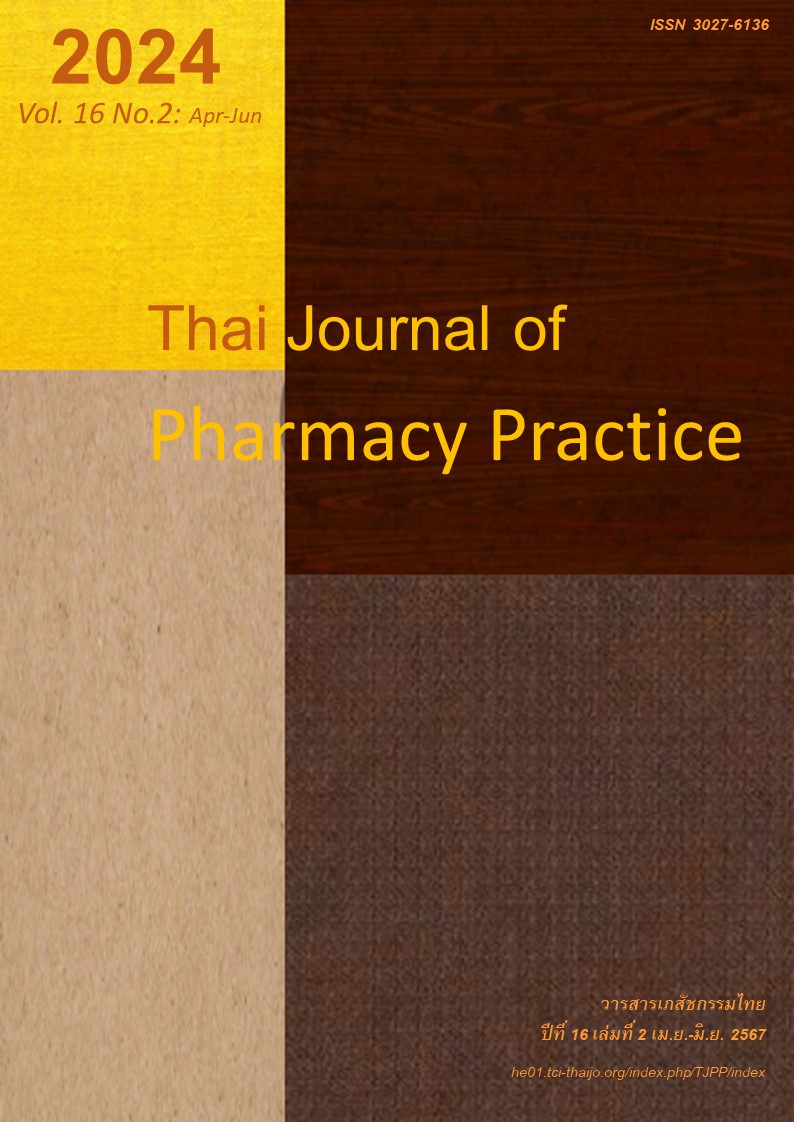ภาวะหมดไฟในการทำงานและความพึงพอใจในการทำงานของเภสัชกรประจำโรงพยาบาล
Main Article Content
บทคัดย่อ
วัตถุประสงค์: เพื่อศึกษาระดับของภาวะหมดไฟและปัจจัยที่สัมพันธ์กับภาวะดังกล่าวในเภสัชกรประจำโรงพยาบาล และเพื่อศึกษาความสัมพันธ์ระหว่างภาวะหมดไฟและความพึงพอใจในการทำงาน ตลอดจนแนวทางที่เภสัชกรรายงานว่าใช้เมื่อเกิดภาวะหมดไฟ วิธีการ: การศึกษานี้เป็นการวิจัยเชิงสำรวจแบบภาคตัดขวางของเภสัชกรประจำโรงพยาบาลที่สังกัดกระทรวงสาธารณสุข ซึ่งปฏิบัติงานมาอย่างน้อย 1 ปี จำนวน 1,400 คน การเลือกตัวอย่างใช้วิธีการสุ่มแบบแบ่งชั้นตามเขตสุขภาพ ผู้วิจัยส่งจดหมายที่มีคิวอาร์โค้ดให้แก่กลุ่มตัวอย่างทางไปรษณีย์ เพื่อให้ตัวอย่างสแกนคิวอาร์โค้ดเพื่อตอบแบบสอบถามออนไลน์ การประเมินภาวะหมดไฟใช้แบบประเมินของ Mashlach และ Jackson หากพบภาวะหมดไฟอยู่ในระดับสูงอย่างน้อย 1 ด้านจะถือว่ามีภาวะหมดไฟ ความพึงพอใจในการทำงานใช้แบบประเมินของ Smith, Kendall และ Hulin การวิเคราะห์หาปัจจัยด้านการทำงานและความพึงพอใจในการทำงานต่อภาวะหมดไฟในการทำงานใช้สถิติ logistic regression ผลการวิจัย: เภสัชกรร้อยละ 31.2 ตอบกลับแบบสอบถาม ซึ่งมีความสมบูรณ์สามารถนำมาวิเคราะห์ได้ 406 ราย เภสัชกรร้อยละ 29.6 มีภาวะหมดไฟโดยเฉพาะอย่างยิ่งด้านความอ่อนล้าทางอารมณ์ (ร้อยละ 23.4) ผู้ที่ปฏิบัติงาน 1-10 ปีและมีจำนวนชั่วโมงปฏิบัติงานนอกเวลามากกว่า 31 ชั่วโมงต่อสัปดาห์มีโอกาสเกิดภาวะหมดไฟเป็น 3.82, และ 2.26 เท่าของผู้ที่ไม่มีลักษณะดังกล่าว ขณะที่ความพึงพอใจในการทำงานลักษณะการบังคับบัญชา โดยเฉพาะอย่างยิ่งพฤติกรรมของผู้บังคับบัญชาสัมพันธ์กับภาวะหมดไฟที่ลดลง(odds ratio = 0.57) การผ่อนคลายความเครียดด้วยการทำกิจกรรมที่ชอบเป็นวิธีการลดภาวะหมดไฟที่ทั้งกลุ่มที่มีและไม่มีอาการหมดไฟ เลือกมากที่สุด สรุป: หนึ่งในสามของเภสัชกรโรงพยาบาลมีภาวะหมดไฟในการทำงาน ระยะเวลาในการปฏิบัติงานและจำนวนชั่วโมงที่ต้องปฏิบัติงานนอกเวลาเป็นปัจจัยที่สัมพันธ์กับการเกิดภาวะหมดไฟ ความพึงพอใจในการทำงานด้านลักษณะการบังคับบัญชาเป็นปัจจัยที่ช่วยป้องกันการเกิดภาวะหมดไฟ แนวทางที่เภสัชกรรายงานว่าเลือกใช้มากที่สุดเมื่อเกิดภาวะหมดไฟ คือ การผ่อนคลายความเครียดด้วยการทำกิจกรรมที่ชอบ
Article Details

อนุญาตภายใต้เงื่อนไข Creative Commons Attribution-NonCommercial-NoDerivatives 4.0 International License.
ผลการวิจัยและความคิดเห็นที่ปรากฏในบทความถือเป็นความคิดเห็นและอยู่ในความรับผิดชอบของผู้นิพนธ์ มิใช่ความเห็นหรือความรับผิดชอบของกองบรรณาธิการ หรือคณะเภสัชศาสตร์ มหาวิทยาลัยสงขลานครินทร์ ทั้งนี้ไม่รวมความผิดพลาดอันเกิดจากการพิมพ์ บทความที่ได้รับการเผยแพร่โดยวารสารเภสัชกรรมไทยถือเป็นสิทธิ์ของวารสารฯ
เอกสารอ้างอิง
Lerkiatbundit S. Job Burnout: development, defini- tions and measurement. Songklanakarin Journal of Social Sciences and Humanities 1999; 5: 167-80.
Srikam S. Job burnout and related factors among residents of King Chulalongkorn Memorial Hopital [master thesis]. Bangkok: Chulalongkorn University; 2013.
Lerthattasilp T. Burnout among psychiatrists in Thai- land: National survey. Journal of the Psychiatric Asso- ciation of Thailand.2011; 56: 437-48.
Charuroadchinda P. Relation between stress and mental health of nurses in Nakorn Pathom [master thesis]. Bangkok: Mahidol University; 2002.
Thanakarn N. Nurse’s job satisfaction at Bumrungrad International Hospital [master thesis]. Bangkok: Mahidol University; 2010.
Jones GM, Roe NA, Louden L, Tubbs CR. Factors associated with burnout among US hospital clinical pharmacy practitioners: results of a nationwide pilot survey. Hosp Pharm 2017; 52: 742-51.
Boonkwang J. Relationships between job stress, Job satisfaction and life satisfaction of hospital pharma- cists under the Office of Public Health Permanent Secretary in the Northeast Region of Thailand. Isan Journal of Pharmaceutical Sciences 2014; 10: 186-97.
Sirilak S, Boonyaphaisarncharoen T, Mungdee T. In: Prakhongsai P, editors. Public health of Thailand 2011-2015. Bangkok: The War Veterans Organiza- tion; 2016. p.192-233.
Lea VM, Corlett SA, Rodgers RM. Workload and its impact on community pharmacists' job satisfaction and stress: a review of the literature. Int J Pharm Pract 2012; 20: 259-71.
Higuchi Y, Inagaki M, Koyama T, Kitamura Y, Sendo T, Fujimori M, et al. A cross-sectional study of psychological distress, burnout, and the associated risk factors in hospital pharmacists in Japan. BMC Public Health 2016; 16: 534.
Kwanmuang S. The relationship between Stress, Job satisfaction and Burnout of Nurses at Ramathi bodi Hospital [master thesis]. Bangkok: Kasetsart University; 1998.
El-Ibiary SY, Yam L, Lee KC. Assessment of burnout and associated risk factors among pharmacy practice faculty in the United States. Am J Pharm Educ 2017; 81: 75.
Sammavaj S. Burnout among the staff nurses in Ramathibodi Hospital [master thesis]. Bangkok: Mahidol University; 1989.
Durham ME, Bush PW, Ball AM. Evidence of burnout in health-system pharmacists. Am J Health Syst Pharm 2018; 75: S93-S100.
Doulougeri K, Georganta K, Montgomery A. “Diag nosing” burnout among healthcare professionals: Can we find consensus?. Cogent Medicine 2016; 3: 1237605.
Weichel C, Lee JS, Lee JY. Burnout among hospital pharmacists: Prevalence, self-awareness, and preventive programs in pharmacy school curricula. Can J Hosp Pharm 2021; 74: 309–16.
Balayssac D, Pereira B, Virot J, Collin A, Alapini D, Cuny D, et al. Burnout, associated comorbidities and coping strategies in French community pharmacies-BOP study: a nationwide cross-sectional study. PLoS One 2017; 12: e0182956.
Dee J, Dhuhaibawi N, Hayden JC. A systematic review and pooled prevalence of burnout in pharma cists. Int J Clin Pharm 2022. doi: 10.1007/s11096-022-01520-6.
Siwakarn W. Job burnout in Hospital Pharmacists, Office of the permanent Secretary of the Ministry of Public Health [master thesis]. Nakhon Pathom: Silpa korn University; 2010.
Calgan Z, Aslan D, Yegenoglu S. Community pharmacists’ burnout levels and related factors: an example from Turkey. Int J Clin Pharm 2011; 33: 92-100.
Zhao J, Zhang X, Du S. Factors associated with burnout and job satisfaction in Chinese hospital pharmacists. Medicine 2020; 99: e21919.
Subramaniam N, Sidik SM, Choi CS, Muthiah SG. Prevalence of burnout and its predictors among pharmacists working in government hospitals in Selangor. Mal J Med Health Sci 2022; 18: 92-102.
Berassa MS, Chiro TA, Fanta S. Assessment of job satisfaction among pharmacy professionals. J Pharm Policy Pract 2021; 14: 71.
Rouotsalained JH, Verbeek JH, Marine A, Serra C. Preventing occupational stress in healthcare workers Cochrane Database Syst Rev 2015; 2015 (4): CD002892.
Romani M, Ashkar K. Burnout among physicians. Libyan J Med 2014; 9: 23556. doi: 10.3402/ljm.v9. 23556.
Aryankhesal A, Mohammadibakhsh R, Hamidi Y, Alidoost S, Behzadifar M, Sohrabi R, et al. Interven tions on reducing burnout in physicians and nurses: A systematic review. Med J Islam Repub Iran 2019; 33: 77.
Wiederhold BK, Cipresso P, Pizzioli D, Wiederhold M, Riva G. Intervention for physician burnout: A systematic review. Open Med 2018; 13: 253-63.
Gopal R, Glasheen JJ, Miyoshi TJ, Prochazka AV. Burnout and internal medicine resident work-hour restrictions. Arch Intern Med 2005; 165: 2595-600.
Maria P, Efharis P, Peter B, George L, Evangelos K, Carolyn C-G. Controlled interventions to reduce burnout in physicians a systematic review and meta-analysis. JAMA Intern Med 2017; 177: 195-205.
De Simone S, Vargas M, Servillo G. Organizational strategies to reduce physician burnout: a systematic review and meta-analysis. Aging Clin Exp Res 2021; 33: 883-94.
Lee RT, Seo B, Hladkyj S, Lovell BL, Schwartzmann L. Correlates of physician burnout across regions and specialties: a meta-analysis. Hum Resour Health 2013; 11: 48.


